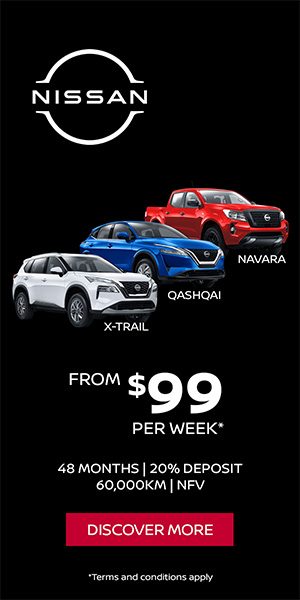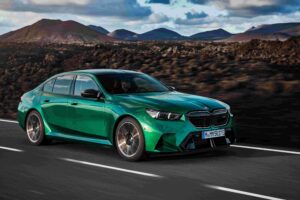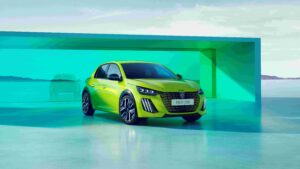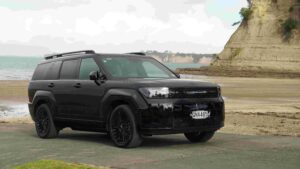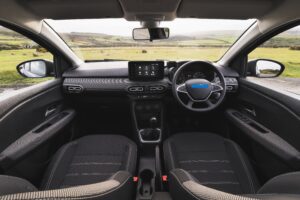PRESS RELEASE
New Zealand specifications of the Next-Gen Ford Ranger have been confirmed, with the highlights being the new-to-Ranger 3.0L V6 turbodiesel engine with 184 kW of power at 3,250 rpm and 600 Nm of torque, full-time 4WD, and six selectable drive modes.
The Next-Gen Ranger has taken the immense success of Ranger, and improved it with customer-led
design and an impressive suite of technology, safety, comfort and drivetrain features.
Whether a customer’s priority is fuel economy, refinement, towing or hauling the powertrains chosen
for Next-Gen Ranger will provide customers with compelling performance and capability, according to
Pritika Maharaj, Ranger and Everest program manager.
The highlight is the addition of Ford’s proven 3.0-litre V6 turbo-diesel, which is being offered on both
Ranger and the Everest SUV. “We’re offering this engine specifically because some customers told
us they wanted more power and torque for towing and extreme off-roading,” said Maharaj.
Ford engineers treated the 3.0-litre V6 turbo-diesel like a brand-new engine, resulting in 184 kW of
power at 3,250 rpm and 600Nm of torque from 1,750-2,250 rpm in both Ranger and Everest. “We did
a lot of application calibration and validation work in both the US and Australia to make sure it would
meet the needs of Ranger and Everest customers,” said Maharaj.
“The 3.0-litre V6 turbodiesel delivers,” added Maharaj. “When you drive a Ranger with the V6
turbodiesel, it feels like a much bigger truck. And it feels strong in the sense that it’s got plenty of
power and torque, which is exactly what our customers told us they wanted.”
In addition to the 3.0-litre V6 turbodiesel engine, the Next-Gen Ranger will offer the choice of a
Single-Turbo 2.0-litre and the Bi-Turbo 2.0-litre inline four-cylinder diesels. Ford’s proven 2.0-litre Bi-Turbo makes 154 kW at 3,750 rpm and 500 Nm from 1,750-2,000 rpm and will also continue to be available in Everest. This engine boasts a clever bypass system that determines the optimum operating mode, meaning the turbochargers can operate in series (at lower engine speeds for enhanced torque and responsiveness) or the smaller turbo can be bypassed allowing the larger turbocharger to deliver high power.
The Single Turbo diesel will offer 125 kW at 3,500 rpm and 405 Nm from 1,750-2,500 rpm. Transmission choices include a 10-speed auto that also sees service in the Ford F-150 and F-150 Raptor and has notched up more than six million kilometres of testing, including more than 3,900 km of sanctioned off-road racing, including at the Baja 1000. This transmission will be available on the 3.0-litre V6 and 2.0-litre Bi-Turbo engines, across Ranger and Everest. The current six-speed automatic transmission available on Ranger will continue with the 2.0L Single Turbo.
“Our customers told us that one of the reasons they love Ranger is because it’s one of the best vehicles on the road for ride comfort and car-like performance. So, retaining that and balancing it with off-road performance has been key throughout the development of Next-Generation Ranger,” said Rob Hugo, dynamic experiences supervisor, Ranger.
A 50mm track and wheelbase increase for Next-Gen Ranger has improved vehicle stability on- and off-road, said Hugo. It has also an improved the front approach angle and rear departure angle. Further to the track increase which helped the team increase the width of Next-Gen Ranger’s tray for a more versatile load space – which now fits a Euro pallet – the rear dampers were moved outboard of the springs which makes for a more controlled ride whether the vehicle is laden or not. The load space is made even more versatile with the addition of a 1-metre ruler and cupholders built into the tailgate work surface.
“The outboard dampers have allowed us to tune a more controlled ride whether the vehicle is carrying a heavy load or not and solve a common complaint of pickups with inboard mounted dampers that they can bounce or skip when unladen,” Hugo said.
There’s now more storage space on the inside of Next-Gen Ranger too, from under-seat storage on Super and Double Cab models to retractable cup holders on Wildtrak and Raptor models and a raft of cubby holes stashed around the cabin. Moulded slots in the bedliner allow you to fit dividers to customise the tray, allowing you to store gear and stop it from sliding around. Whether you’re a traditionalist or someone looking for additional peace-of-mind on the road, Ford is offering two four-wheel drive systems for Next-Gen Ranger. The base four-wheel drive is a ‘part-time’ system with a two-speed electronic shift-on-the-fly transfer case offering 2H, 4H and 4L as modes of operation.
Next-Gen Ranger is also available with an on-demand four-wheel drive system (2H, 4A, 4H, and 4L) which allows Ranger to be driven in four-wheel drive on high-traction surfaces via its 4A (automatic) mode. When selected, the system continuously distributes power between the front and rear axles for optimum performance in all on-road conditions.
“This means a Ranger driver can just leave the truck in four-wheel drive (4A) and head off down the highway, down a country road, over a snowy mountain or across a sand dune without having to do
anything else,” Hugo said.
Next-Gen Ranger continues to be offered with an electronic rear differential lock which can be
activated via the SYNC® screen. A differential lock allows both wheels on a specific axle to turn at the same speed providing additional traction when you’re off-roading. Selectable Drive Modes for Added Confidence on the Go It used to be that only Ranger Raptor offered selectable drive modes, but now Next-Gen Ranger will offer up to six, depending on the variant, with Raptor seven. The modes are: Normal, Eco, Tow/Haul, Slippery for on-road, and Mud/Ruts and Sand for use off-road. Raptor gets additional Sport, Rock Crawl and Baja modes. These modes adjust everything from the gearshift to throttle response, traction and stability controls, ABS and more.
“These selectable drive modes are a very simple way of getting advanced traction to the wheels the
way it needs to be delivered without having to be an expert,” said Hugo.
Tow/Haul mode is a brand-new drive mode and is designed for those towing or carrying a heavy load
in their Ranger. Selecting Tow/Haul mode optimises the gear shift timing to maintain power when you’re climbing up a hill or deliver the right amount of engine braking when you’re travelling down a hill. Next-Gen Ranger continues with a maximum braked towing capacity of 3,500 kg with a 350 kg towball download limit.
Off-Road Screen
In Sport and Wildtrak models, drivers can access Ranger’s dedicated off-road screen which displays information related to the vehicle’s position and performance. It is designed to help you get the most
out of your vehicle’s off-road driving capabilities by displaying:
• Driveline and Electronic Diff Lock indication
• Steering angle
• Vehicle pitch and roll angles
• Features buttons available at all times
This feature is further enhanced by the addition of Wildtrak’s 360-degree camera which with a front camera view of the terrain ahead, provides additional visibility and predictive overlay guidelines helping the driver negotiate obstacles
Towing to the Max
Ranger’s 3,500kg braked towing capability (2,500kg Ranger Raptor) is maintained and suspension upgrades on Next-Gen Ranger deliver even better ride control and comfort whilst towing or hauling heavy loads. On XLT models and above, Ranger also now features rear disc brakes as standard for even better towing performance.
To make towing heavy loads easier and safer, Wildtrak now includes an integrated electronic trailer brake controller. The integrated trailer brake controller ensures smooth and effective trailer braking by powering the trailer’s electric brakes with a proportional output based on the towing vehicle’s brake pressure.
The controller adapts its output based on the status of the Anti-Lock Brake System (ABS). When the ABS module senses the towing vehicle’s brakes are approaching lockup, the controller’s braking strategy changes to compensate for traction conditions, reducing the risk of trailer brake lockup. The system also provides instant visual/audible warning in case of accidental trailer disconnect.
BLIS with Cross-Traffic Alert and Trailer Coverage is a first for Ranger and offers Blind Spot Information System (BLIS) coverage for pick-up models and the trailer it’s towing. Using sensors built into the taillamps, BLIS can alert the driver when a vehicle in an adjacent lane is detected in the blind spot, which helps avoid collisions when switching lanes. In vehicles fitted with Ford’s factory Tow Pack, the Trailer Coverage system can be set to the length of the trailer, supporting trailers up to 2.4 metres wide and 10 metres long. The system also allows you to store your trailer’s dimensions for quick setup. Once set, the system re-adjusts to account for the trailer, picking up vehicles in the customer’s blind spot sooner.
Integrated SYNC 4A features such as trailer connection checklist & Trailer Light Check simplifies the task of connecting your trailer by no longer having to rely on another person to act as a spotter, or for the driver to have to get out of the vehicle Ranger XLT models and up (excluding Raptor) feature the Tow/Haul drive mode which optimises gear shift timing to maintain best power delivery and engine braking and reduce shift busyness when towing.
Engine & Transmission
Next-Gen Ford Ranger XL
• 2.0L Single Turbo with 6-speed automatic – 4×2 models only
• 2.0L Bi-Turbo with 10-speed automatic and part-time 4×4 – 4×4 models only
Next-Gen Ranger XLT
• 2.0L Bi-Turbo with 10-speed automatic, 4×2 or Part-Time 4×4
Next-Gen Ford Ranger Sport
• 3.0L V6 turbo-diesel with 10-speed automatic, full-time 4WD, e-Shifter and Electronic Park
Brake
Next-Gen Ranger Wildtrak
• 2.0L Bi-Turbo with 10-speed automatic, part-time 4×4, e-Shifter and Electronic Park Brake
• Optional 3.0L V6 turbo-diesel with 10-speed automatic, full-time 4WD, e-Shifter and
Electronic Park Brake
Next-Gen Ford Ranger Raptor
3.0-litre V6 Twin-Turbo EcoBoost with 10-Speed Automatic

